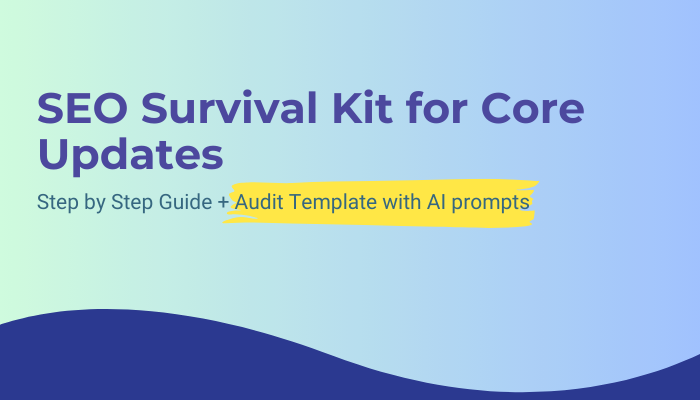The SEO Survival Kit for Google Core Updates

Your Playbook for How to Evaluate and Respond to a Google Core Update, with a complete step-by-step checklist on auditing your site and identifying areas of improvement.
Surviving Core Updates and Coming out on Top
When Google rolls out a Core Update, your site’s performance can change dramatically—sometimes for better, sometimes for worse. The key to making the most out of these updates is not just identifying what went wrong, but also understanding what went well and why. This guide will help you assess the impact of a Core Update, using data-driven approaches to fine-tune your SEO strategy and set your site up for long-term success.
Understanding Traffic Fluctuations: More Than Just Numbers
A sudden change in traffic is often the first sign that your site has been impacted by a Core Update. But don’t stop at noticing a spike or dip—dig deeper to understand why the change occurred. This insight is where you find the real value: was your content rewarded for its depth and relevance, or did your traffic drop because it no longer meets Google’s new content standards?
Why It Matters:
Knowing the cause of traffic fluctuations lets you replicate what worked and fix what didn’t. A traffic increase means that Google has recognized and rewarded certain strengths in your content—perhaps the depth, user intent alignment, or freshness. A drop, on the other hand, points to gaps that need addressing.
What to Do:
- Use Google Analytics: Segment traffic by content type (blog posts, product pages, etc.) to pinpoint specific areas affected.
- Compare pre- and post-update traffic: See where the biggest shifts happened in relation to the Core Update rollout.
Keyword Performance: A Window Into Google’s Evolving Preferences
Keyword ranking shifts are another key indicator of how your site has fared post-update. But here’s the important part: don’t just focus on where you lost rankings. Pay close attention to the keywords where you gained rankings, too.
Why It Matters:
When keywords see improvement, it’s a sign that your content aligns with Google’s new preferences. For instance, if niche, long-tail keywords started performing better, that’s a signal that Google is prioritizing more specific, detailed content for those queries. Conversely, drops in certain keywords might point to areas where your content no longer meets Google’s expectations.
Example:
Imagine you run a health and wellness site, and your article on “natural headache remedies” climbed the rankings. This suggests Google is favoring more comprehensive, natural health content. If, however, your short, generic article on “headache treatments” dropped in rankings, it could mean that Google is prioritizing more detailed, specific advice over general information.
What to Do:
- Track keyword ranking changes: Use Google Search Console to monitor which keywords gained or lost rankings.
- Focus on successful keywords: Analyze what worked for the keywords that gained and apply those strategies across your content.
Content Quality Assessment: The Core of the Update
Google’s Core Updates are, at their heart, about content quality. If your site saw a decline in traffic, it might be a signal that your content no longer meets Google’s standards for relevance, depth, or usefulness.
Why It Matters:
Content that’s outdated, thin, or irrelevant can be deprioritized by Google after a Core Update. To recover from a traffic drop, you need to evaluate the quality of your content and align it with Google’s focus on user experience and E-E-A-T (Experience, Expertise, Authoritativeness, Trustworthiness).
What to Do:
- Assess content depth: Thin content that doesn’t fully answer user queries can be a red flag. Expand such content to cover the topic more comprehensively.
- Evaluate relevance: Ensure that your content is still solving users' problems and providing value.
- Check uniqueness: Differentiate your content from competitors by offering unique insights, data, or perspectives.
How It Helps:
Improving content quality helps you align with Google’s expectations, reducing the risk of losing rankings in future updates.
Content Freshness and Relevance: Keeping Your Content Updated
Google rewards sites that keep their content fresh and relevant. If some of your pages saw a drop in traffic, it could be because the content is outdated or no longer aligns with user intent.
Why It Matters:
Keeping your content up-to-date ensures that you stay relevant in Google’s eyes. Pages that are left untouched for long periods can fall behind, especially in industries where trends change quickly.
What to Do:
- Identify outdated content: Review content that hasn’t been updated in the last year and refresh it with new data or insights.
- Align with evolving user intent: Update your content to reflect what users are searching for today, not what they were searching for when the content was originally written.
How It Helps:
Sites that update their content regularly see a noticeable boost in performance, with some seeing up to a 27% increase in organic traffic
Segmentation for Deeper Insights: Break It Down to Improve It
Not all content is equally affected by Core Updates. Segmentation helps you dive deeper and see where you need to focus your recovery efforts.
Why It Matters:
Breaking down your data into categories (content types, user intent, etc.) lets you pinpoint where your site is losing or gaining ground and focus your efforts accordingly.
What to Do:
- Segment by content type: Compare how different types of content (e.g., blog posts, product pages) performed.
- Segment by user intent: Look at how content serving transactional, informational, and navigational queries was affected.
Competitive Analysis: Learn from the Competition
A Core Update changes the competitive landscape in the search results. If your rankings dropped but your competitors improved, that’s a signal to look closely at what they’re doing differently.
Why It Matters:
By studying how competitors responded to the Core Update, you can gain insights into how Google is weighing certain factors and apply that knowledge to your own site.
What to Do:
- Track competitor rankings: Identify which competitors saw gains after the update and analyze their content for clues about what’s working.
- Analyze competitor content: Look at their use of keywords, content depth, and user engagement strategies.
Long-Term Trend Analysis: Look Beyond Immediate Fluctuations
While it’s tempting to focus on immediate traffic changes, it’s important to take a step back and evaluate longer-term trends. Doing so helps you avoid overreacting to short-term fluctuations.
Why It Matters:
Trends over several months or a year can tell you more about your site’s health than a short-term traffic spike or drop. By focusing on long-term trends, you’ll be able to spot consistent growth areas and address long-standing weaknesses.
What to Do:
- Use moving averages: Calculate 7-day or 30-day moving averages to smooth out daily fluctuations.
- Compare year-over-year data: Look for patterns that indicate whether the update had a lasting impact.
Action Plan Development: Turn Data Into Strategy
After evaluating your site’s performance, it’s time to turn your insights into an action plan. Prioritize your efforts based on where you can make the most impact.
Why It Matters:
Without a clear action plan, it’s easy to waste time on areas that won’t significantly improve your site. A structured approach helps ensure that you’re focusing on the right priorities.
What to Do:
- Focus on the biggest losses first: Identify pages with the largest traffic drops and address them immediately.
- Build on what worked: Take successful strategies from high-performing pages and apply them to underperforming areas.
- Monitor and iterate: Implement changes and track their performance over time, making adjustments as needed.
By using this balanced approach—analyzing both what worked and what didn’t—you can create an action plan that addresses traffic drops, builds on successes, and ensures long-term success in future Core Updates.
Audit Template
This template walks you step-by-step through how to audit your site post core-update and identify areas that improved or decline, as well as come up with an action plan for the opportunities you discovered.
This also comes with 3 prompts to help automate data analysis and visualisation using AI.
Grab the template, and read the rest of the article here, as well as access other items in the resource library.
Here is a link to the template in Google Docs (notion coming soon)
Directions:
- Make a copy of this to your own drive
- Edit as needed
- Show your boss and pretend you whipped it up and collect praise.




